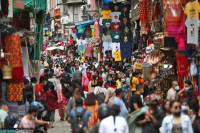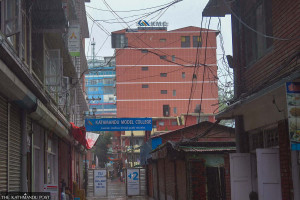Columns
Illicit economy
Human trafficking and drugs are the only two sectors of the economy still thriving in Afghanistan.
Jonathan Goodhand & Jan Koehler
In the frontier town of Zaranj on Afghanistan’s border with Iran, young men jostle one another as they cram into pickups that leave at regular intervals to be smuggled across the border. Human trafficking is one of the few sectors of the Afghan economy that is thriving. Another is drugs.
Some 950 km to the east of Zaranj, on a remote and cold mountain pass, men with backpacks follow the narrow path to the border-crossing at Tabai, before beginning their descent into the “tribal areas” of Pakistan. Hidden in their loads are bags of heroin, bound for markets in Peshawar and Karachi, with much of it ending up on the streets of the UK.
The trade in drugs and people are growing in importance as other sectors of the economy contract or shut down and poverty deepens.
Both illicit economies involve complex logistics, infrastructure and networks of brokerage to enable and funnel flows of people or illegal drugs out of the country. Both have responded with remarkable speed and agility to the political rupture marked by the Taliban takeover.
In Zaranj, prior to the change of regime, people told us that 2014–15 was the high point of the people smuggling industry, when the labour market contracted and the economy slowed down in response to the international military drawdown. Now, the business is booming again, and so are prices.
A report by the Danish Refugee Council found that even before the crisis Afghans were being asked for an average of $1,710 to be transported from Afghanistan to Turkey. It has been estimated that the numbers crossing the border have doubled in recent weeks. Before the Taliban takeover there were around 400 vehicles taking migrants via Pakistan into Iran every day. This rose to some 1,200 in September-October and has now dropped to around 600 vehicles. Fees for the longer Mashkel route via Pakistan initially increased four to six-fold during this period. Official border crossings with Iran are closed for most migrants.
The economic significance of the drugs trade has also grown. When the Taliban took over, drug prices increased significantly. In Nangarhar, dry opium increased from PKR20,000 (Pakistani Rupee—the equivalent of about £86) to PKR33,000 (£141) per Afghan seer, equivalent to about 1.25 kgs. In Nimroz, opium increased from PKR10,000 (£43) to PKR28,000 (£120) per kilo. The spike in prices was driven by traders buying product at a time of uncertainty.
But prices went down and stabilised once it became apparent that the Taliban would consolidate their power swiftly. One sign of confidence in the market has been the opening up of opium bazaars in formerly government-controlled areas. The Taliban’s new monopoly on taxing the drugs trade is manifest in districts such as Durbaba in Nangarhar, where they charge taxes of PKR1,000 (£4.28) per seer of opium, PKR500 (£2.14) per kilo of hashish and PKR2,000 (£8.56) per kilo of heroin.
Taliban and drug economy
Under pressure and under conditions of economic decline and an escalating crisis, the Taliban is unlikely to move against the drug economy. The exception is often draconian measures against drug users in Kabul.
There are no signs yet that the Taliban will target other parts of the drug business, such as cultivation, refining, trade and cross-border trafficking. Unlike ISIS-K (Islamic State Khorasan), drug cultivation and trafficking are not an ideological matter for the Taliban—but more likely a bargaining chip in their negotiations with the west around funding and recognition.
At the same time, those involved in the trade are hedging their bets by stockpiling in case the Taliban’s laissez-faire policy changes.
While the underlying drivers of the drug economy—instability, bad governance and widespread poverty—remain so strong, there is no credible or humane way to achieve sustained reductions in poppy cultivation. Billions of pounds invested in counter narcotics efforts by international actors over the last 20 years failed to do this and the Taliban have neither the resources nor the inclination to enforce drug bans now. To do so would further impoverish a population already in dire straits, and at the same time undermine the Taliban’s core support base in the poppy-growing areas of the Pashtun south. It would also cut off an important source of revenue to the regime.
Borderland businesses
Most of Afghanistan’s illicit drug production and trafficking happens in the borderlands, building on longstanding trading networks and societal connections that predate the modern Afghan state and that have been reinforced and rejuvenated by more than four decades of war.
The sudden withdrawal of western funding has exposed an economy, polity and society heavily shaped by—and dependent on—external financial support, technical assistance and military capacity. In the current context, the Taliban government is going to struggle to support any public sector activity, including the provision of basic health and education services. The possibilities of survival in the borderlands of rural Afghanistan are already severely limited by declining farm sizes and high levels of landlessness, and the repeated droughts wrought by the climate emergency.
People smuggling and drugs are two borderland economies that can be understood as responses to a context of radical uncertainty. Border regions are places of improvisation and innovation, often the first regions to react to moments of rupture and transition. While the licit economy has been hit hard by the banking crisis, the people smuggling and drugs industries continue to be funded by “halwaldars”, the informal money exchange system.
Unfortunately, the international response has been ponderous and dogmatic. An indefinite “wait-and-see” approach by western governments, megaphone diplomacy with the Taliban, or efforts to “quarantine” Afghanistan’s illicit flows will all exacerbate a growing humanitarian, financial, and security crisis with regional and global ramifications. Humanitarian and development funding have to be delivered now, and at scale.
—The Conversation
Read the original article here.




 22.46°C Kathmandu
22.46°C Kathmandu


















